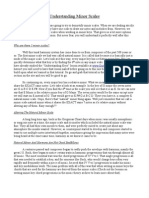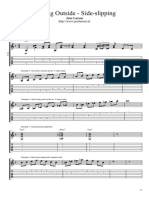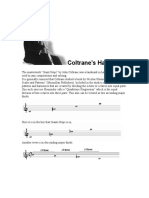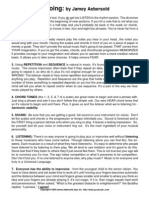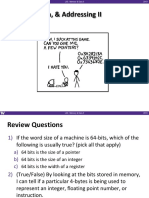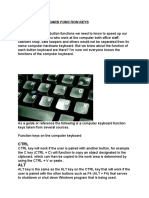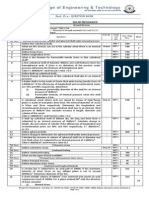Chord Extensions
Chord Extensions
Uploaded by
dixitbhattaCopyright:
Available Formats
Chord Extensions
Chord Extensions
Uploaded by
dixitbhattaCopyright
Available Formats
Share this document
Did you find this document useful?
Is this content inappropriate?
Copyright:
Available Formats
Chord Extensions
Chord Extensions
Uploaded by
dixitbhattaCopyright:
Available Formats
Chord Extensions So far weve looked at intervals, the major and minor scales, and seen the relationship
between them. Weve also derived the chords that come from the major scale triads and then 7th chords. Lets take the chords a little further and look at the extensions, the 9th, 11th and 13th over various 7th chords What do the 9th, 11th and 13th extensions represent? These numbers represent notes that can be thought of as optional extras to be added on top of a chord. Chords with extensions offer richer tonal colouration than the more conventional triads and 7th chords. First a little recap Remember that we worked out the chord of G Maj7 [Root, Major 3rd, Perfect 5th, Major 7th] by using the notes from the key of G major, looking rst from the tonic [the rst note in the scale].
The example above illustrates the chord of G Maj7 being derived from the key of G major. Rule: notes within the chord of X Maj7 are derived from the key of X major. Examples: The key of F is used to derive F Maj7 [and its extensions] The key of Bb is used to derive Bb Maj7 [and its extensions] And so on Extensions over a Maj7 chord: Extensions stack in 3rd intervals over 7th chords. Just like the Maj7 chords intervals, the extensions over X Maj7 are also calculated from the key of X major. We can work out the extensions by running though the notes of the scale and then simply keep counting on further into the next octave. The scale of G major across two octaves: Interval: Note: Tonic G 2nd A 3rd B 4th C 5th D 6th E 7th F# 8th G 9th A 10th B 11th C 12th D 13th E 14th F#
Using the G major scale above, we can see the extensions generated as follows: G Maj9 [spoken G major nine] is built upon the G Maj7 with the addition of the major 9th This is therefore calculated from the G major scale so the 9th is A. [G, B, D, F#, A] The spelling of the Maj9 chord is: Root, major 3rd, perfect 5th, major 7th, major 9th G Maj11 [spoken G major eleven] is built upon the G Maj7 with the addition of the 9th and 11th This is calculated from the G major scale so the 9th is A and the 11th is C. [G, B, D, F#, A, C] The spelling of the Maj11 chord is: Root, major 3rd, perfect 5th, major 7th, major 9th, perfect 11th [because it is an extension of the 4th] G Maj13 [spoken G major thirteen] is built upon the G Maj7 with the addition of the 9th, 11th and 13th This is calculated from the G major scale so the 9th is A, 11th is C and the 13th is E. [G, B, D, F#, A, C, E]
Added notes:
When looking at theMaj7, Maj9, Maj11 and Maj13 chords the notes all stack up in a way where each chord is essentially built upon the last. However, you can add extension notes individually to a chord so that you do not need to have the all extension notes. The name these chords, you work out the highest chord name where the notes stack in 3rd intervals and then add the additional extensions.
Examples: Imagine a G major triad with an additional 9th but the 7th was not required. The G major triad is the highest chord name where the 3rd intervals are unbroken and the 9th is added. This therefore the chord of G with an added 9th - G, B, D, A Name: G add 9 Imagine a G Maj7 chord had an added 13th the 9th and 11th were not present. The G Maj7 chord is the highest chord name where the 3rd intervals are unbroken and the 13th added. This therefore the chord of G Maj7 with an added 13th - G, B, D, F#, E Name: G Maj7 add 13 Extensions over minor chords: The minor extended chords follow slightly different rules. Consider the chord to be made up of two parts 1 - the minor triad [Xm] or the minor triad with the 7th [Xm7] these note values are determined by the minor key from which this chord is derived [the chord of Xm in the key of Xm] 2 - the extensions these are the notes above the 7th [the 9th, 11th and 13th] and are derived from the major key upon which the minor chord is rooted. The extension notes above the chord of Xm7 are therefore derived from the key of X major. This time the extension notes however are calculated from the major scale. Em11 [spoken E minor eleven] is therefore worked out in two parts The Em7 part comes from the key of Em, the extensions come from the key of E Em11 contains - E, G, B, D, F#, A The spelling of the m11 chord is: Root, minor 3rd, perfect 5th, minor 7th, major 9th, perfect 11th Em9 add 13 [spoken E minor nine add thirteen] is an Em9 chord with the 13th added [with no 11th] Em9 add 13 contains - E, G, B, D, F#, C#. [the note A is omitted] The spelling of the m9 add 13 chord is: Root, minor 3rd, perfect 5th, minor 7th, major 9th, major 13th Getting the idea? Lastly, the slightly more awkward chords to handle, the dominant chords. Again these follow exactly the same rules but with one main difference. The root note is the Dominant note [5th degree] from another major key. This means that the chord of D7 [spoken D seven] is taken from the major key where the root note D is the 5th from another key D is the 5th in the key of G major, and so this key is used to work out the extensions. Examples: D11 [spoken D eleven] The root D is a perfect 5th above the note G so the key of G major is used to derive the notes of the chord. D11 contains - D, F#, A, C, E, G [from the scale of G major: G, A, B, C, D, E, F#] The spelling of the dominant 11 chord is: Root, major 3rd, perfect 5th, minor 7th, major 9th, perfect 11th B9 [spoken B nine] The root B is a perfect 5th above the note E so the key of E major is used to derive the notes of the chord. B9 contains - B, D#, F#, A, C# [from the scale of E major: E, F#, G#, A, B, C#, D#] The spelling of the dominant 9 chord is: Root, major 3rd, perfect 5th, minor 7th, major 9th G7 add 13 [spoken G seven add thirteen] The root C a perfect 5th above the note C so the key of C major is used to derive the notes of the chord G7 add 13 contains - G, B, D, F, E [from the scale of C major: C, D, E, F, G, A, B] The spelling of the dominant 7 add 13 chord is: Root, major 3rd, perfect 5th, minor 7th, major 13th
You might also like
- Pub - Visualizing Human Geography at Home in A Diverse W PDFDocument466 pagesPub - Visualizing Human Geography at Home in A Diverse W PDFdixitbhatta100% (2)
- Chu Shong TinDocument21 pagesChu Shong Tinjkd01100% (11)
- Half Step, Whole Step, Enharmonic Review: - ,..,..-::,9::ielepi:#Document1 pageHalf Step, Whole Step, Enharmonic Review: - ,..,..-::,9::ielepi:#Orlando RiveraNo ratings yet
- Justin Derrico - ROCK TRIADS LICK-A-PEDIADocument12 pagesJustin Derrico - ROCK TRIADS LICK-A-PEDIAGuillermoMarceloPonceNo ratings yet
- Composition Exercise 2b - Slicing The Cake Quadrants of The Circle of 5thsDocument1 pageComposition Exercise 2b - Slicing The Cake Quadrants of The Circle of 5thsBen PringleNo ratings yet
- Harmonic Analysis Jazz Chord Sequences - Just Intonation PDFDocument8 pagesHarmonic Analysis Jazz Chord Sequences - Just Intonation PDFdavid100% (1)
- Harmonic Circles 1Document4 pagesHarmonic Circles 1Fabián GallinaNo ratings yet
- Chord How It's Formed ResolutionDocument4 pagesChord How It's Formed ResolutionDaniel AgiusNo ratings yet
- The Art of The Added SubV7Document2 pagesThe Art of The Added SubV7Engin RecepoğullarıNo ratings yet
- A Map of The Interconnection Between Keys: Fractal Key of That NoteDocument1 pageA Map of The Interconnection Between Keys: Fractal Key of That NoteJohn Arturo Talavera MendozaNo ratings yet
- Triad Spread VoicingsDocument2 pagesTriad Spread Voicingsdrewdrew525100% (1)
- Pentatonics and Blues Solo Mastery Module 4 Pentatonic and Blues ScalesDocument11 pagesPentatonics and Blues Solo Mastery Module 4 Pentatonic and Blues Scaleshogar100% (1)
- Soloing and VampingDocument1 pageSoloing and Vampingapi-3832119100% (1)
- 1.voice Leading ArpeggiosDocument4 pages1.voice Leading ArpeggiosJan FunkygoodTimeNo ratings yet
- Minor ScalesDocument4 pagesMinor ScalesNa'amanMagnusAnthonyNo ratings yet
- Let's Stay Together - EDocument1 pageLet's Stay Together - ERafael SemtchukNo ratings yet
- Improvising Tools Part 3: Arpeggio Patterns: Chart #1Document5 pagesImprovising Tools Part 3: Arpeggio Patterns: Chart #1Marc whitehathacking100% (1)
- Backcycling Music TheoryDocument5 pagesBackcycling Music TheorysuriyaprakashNo ratings yet
- Shell Voicings Week 3Document3 pagesShell Voicings Week 3FelipeNo ratings yet
- DoDOMINANT CHORD TRIAD PAIRSminant Chord Triad PairsDocument1 pageDoDOMINANT CHORD TRIAD PAIRSminant Chord Triad Pairsedwhite18No ratings yet
- Harmonic Circles 2Document3 pagesHarmonic Circles 2Fabián GallinaNo ratings yet
- Giant Steps EbDocument3 pagesGiant Steps EbJavier Alejandro Castruita LechugaNo ratings yet
- Minor TriadsDocument231 pagesMinor TriadsMario StiflerNo ratings yet
- Guitar Chord VoicingsDocument248 pagesGuitar Chord VoicingsVivito NozzyNo ratings yet
- Learn How To Play The Jazz 251 Chord Progression On Piano!Document4 pagesLearn How To Play The Jazz 251 Chord Progression On Piano!abel habtamuNo ratings yet
- Giovanni Moltoni - Guit-NotesDocument23 pagesGiovanni Moltoni - Guit-Notesalessandro Pasqual100% (1)
- Jazz BookDocument27 pagesJazz BookScribdTranslationsNo ratings yet
- Excerpt 52 Chord ProgressionDocument8 pagesExcerpt 52 Chord ProgressionSilvana AndradeNo ratings yet
- Room 335Document2 pagesRoom 335Gerardo GaezNo ratings yet
- The General Tonal Center Concept For Jazz ImprovisationDocument4 pagesThe General Tonal Center Concept For Jazz ImprovisationproducerwilljNo ratings yet
- Augmented Triads On GuitarDocument6 pagesAugmented Triads On GuitarRonald García DeronceleNo ratings yet
- 2-5-1s (3rds & 7ths)Document1 page2-5-1s (3rds & 7ths)Paul WatsonNo ratings yet
- Playing Outside - Side-Slipping: Jens LarsenDocument2 pagesPlaying Outside - Side-Slipping: Jens LarsenMiguel100% (1)
- EQUINOX - BB InstrumentsDocument1 pageEQUINOX - BB InstrumentsCiccioFormaggioNo ratings yet
- Tritone Chord Substitution - Jazz Guitar OnlineDocument2 pagesTritone Chord Substitution - Jazz Guitar OnlineNicky AlejandrinoNo ratings yet
- Chord FormulaeDocument6 pagesChord FormulaevinuyeNo ratings yet
- Melodic Mode JazzDocument2 pagesMelodic Mode Jazzdannyrorke9530No ratings yet
- Guide Tones Example 2Document1 pageGuide Tones Example 2celezavirtualNo ratings yet
- Soulful-Keys - Chords Information: File Name (BPM) Key Chords InfoDocument3 pagesSoulful-Keys - Chords Information: File Name (BPM) Key Chords InfoMiguel DiasNo ratings yet
- QNMDocument10 pagesQNMMark BrewerNo ratings yet
- Altered Chord - WikipediaDocument29 pagesAltered Chord - WikipediaHuỳnh Lê Hoài BảoNo ratings yet
- Chord Substitutions: The TritoneDocument7 pagesChord Substitutions: The Tritonescaldanabr100% (1)
- Chord RelationsDocument4 pagesChord Relationsandmer100% (1)
- Chord VoicingDocument17 pagesChord VoicingLeoSarmentoNo ratings yet
- A Melodic Minor Scale: A B C D E F# G# FormulaDocument5 pagesA Melodic Minor Scale: A B C D E F# G# FormulaBGNo ratings yet
- Scales PracticeDocument1 pageScales PracticePety Montiel100% (2)
- TritoneDocument10 pagesTritoneYero RuNo ratings yet
- Coltrane Harmony For GuitarDocument4 pagesColtrane Harmony For Guitarxzxhiujinh100% (1)
- Augmented Scale - The Jazz Piano SiteDocument5 pagesAugmented Scale - The Jazz Piano SiteMbolafab Rbj100% (1)
- 04 SoloingDocument1 page04 Soloingsuzytwo100% (1)
- Avoid NoteDocument3 pagesAvoid NoteRicardo HenriqueNo ratings yet
- Piano Super Locrian (Altered Scale) - Overview With Pictures PDFDocument4 pagesPiano Super Locrian (Altered Scale) - Overview With Pictures PDFВладимир Перминов100% (1)
- Quartal Chord Voicings - The Jazz Piano SiteDocument8 pagesQuartal Chord Voicings - The Jazz Piano Sitekracker43No ratings yet
- Hellomusictheory Negative HarmonyDocument15 pagesHellomusictheory Negative HarmonyF.O.G. ProductionsNo ratings yet
- Diatonic Upper ExtensionsDocument4 pagesDiatonic Upper ExtensionsDavid MoorheadNo ratings yet
- What Are IntervalsDocument6 pagesWhat Are IntervalsknightbajoNo ratings yet
- Adding Notes To Chords - Summary: The 9th, 11th & 13thDocument7 pagesAdding Notes To Chords - Summary: The 9th, 11th & 13thDiego100% (2)
- Adding Notes To Chords - Summary: The 9th, 11th & 13thDocument7 pagesAdding Notes To Chords - Summary: The 9th, 11th & 13thvedat taşNo ratings yet
- A World of Nations & States: Chapter 10 Lecture OutlineDocument39 pagesA World of Nations & States: Chapter 10 Lecture OutlinedixitbhattaNo ratings yet
- The Geography of Religion: Chapter 8 Lecture OutlineDocument25 pagesThe Geography of Religion: Chapter 8 Lecture OutlinedixitbhattaNo ratings yet
- A Theory of Personal Language and Implications For Logos TheologyDocument8 pagesA Theory of Personal Language and Implications For Logos TheologydixitbhattaNo ratings yet
- Retrogade Time For Differnent PlanetsDocument1 pageRetrogade Time For Differnent PlanetsdixitbhattaNo ratings yet
- CC PaperDocument30 pagesCC PaperdixitbhattaNo ratings yet
- 03 04 ModulationDocument1 page03 04 ModulationdixitbhattaNo ratings yet
- Lead Patterns Using The Minor Pentatonic Scale!: Professor Jim's Rock SchoolDocument6 pagesLead Patterns Using The Minor Pentatonic Scale!: Professor Jim's Rock SchooldixitbhattaNo ratings yet
- Udec2104 May2020Document7 pagesUdec2104 May2020A/P SUPAYA SHALININo ratings yet
- 2222need For An Anterior Point of Reference in Face Bow Transfer The Changing Viewpoint Changing Concepts Regarding Anterior Reference PointDocument3 pages2222need For An Anterior Point of Reference in Face Bow Transfer The Changing Viewpoint Changing Concepts Regarding Anterior Reference PointDr. Zardasht N. BradostyNo ratings yet
- Craftsman Vs DesignerDocument33 pagesCraftsman Vs DesignerLina MarlianiNo ratings yet
- Chromatography PharmacyDocument41 pagesChromatography PharmacyfarisaNo ratings yet
- Blue Futuristic Illustrative Artificial Intelligence Project PresentationDocument11 pagesBlue Futuristic Illustrative Artificial Intelligence Project Presentationdavenguting20No ratings yet
- Hybris Arch PDFDocument23 pagesHybris Arch PDFpraveen.saxena8459No ratings yet
- IMO MATH class 8Document37 pagesIMO MATH class 8Aniket IsGamerNo ratings yet
- Effect of Current On EDMDocument58 pagesEffect of Current On EDMAli M. ElghawailNo ratings yet
- Course 11 OOP: Graphical User Interfaces in SwingDocument20 pagesCourse 11 OOP: Graphical User Interfaces in SwingcrengutabogdanNo ratings yet
- Every Job.: For Off-Highway ApplicationsDocument8 pagesEvery Job.: For Off-Highway ApplicationsJoão Paulo TavaresNo ratings yet
- Sustainability 11 05355 v2Document24 pagesSustainability 11 05355 v2Singam SridharNo ratings yet
- Microsoft Project-2013 Training ContentsDocument7 pagesMicrosoft Project-2013 Training ContentsMuhammad Asim RashidNo ratings yet
- HW 3Document2 pagesHW 3chrislmcNo ratings yet
- Basis Set Effects On The Stability of The CL O Isomers Using B3P86 and B3LYP Methods of Density Functional TheoryDocument7 pagesBasis Set Effects On The Stability of The CL O Isomers Using B3P86 and B3LYP Methods of Density Functional TheoryeleazarNo ratings yet
- L03 Memory IIDocument30 pagesL03 Memory IIHuế Trần NgọcNo ratings yet
- CSS Animation 101 Animations in ActionDocument5 pagesCSS Animation 101 Animations in ActionKulin BanNo ratings yet
- Syllabus BME 21 22 4YDocument15 pagesSyllabus BME 21 22 4Yriturajkashyap0104No ratings yet
- Alternative Fuels TechnologyDocument67 pagesAlternative Fuels TechnologySameerSathwick100% (1)
- Changes in Masculine and Feminine Traits Over Time A Meta-AnalysisDocument21 pagesChanges in Masculine and Feminine Traits Over Time A Meta-AnalysisGiovanni CorteNo ratings yet
- Chemistry (P-Block Group 13 - 14) Answer Key: Single Choice Questions Solution 1: (D)Document11 pagesChemistry (P-Block Group 13 - 14) Answer Key: Single Choice Questions Solution 1: (D)Dhruv KuchhalNo ratings yet
- Tugas KeysDocument3 pagesTugas KeysIVa LatifahNo ratings yet
- RLtool TutorialDocument8 pagesRLtool TutorialShoaib Ahmed SiddiqueNo ratings yet
- Datasheet Legend 800 Pcie Gen4 x4 m2 2280 SSD 20240531Document2 pagesDatasheet Legend 800 Pcie Gen4 x4 m2 2280 SSD 20240531RinggaputraNo ratings yet
- SPE 185472 New Trends in Waterflooding Project OptimizationDocument29 pagesSPE 185472 New Trends in Waterflooding Project Optimizationk.leya424No ratings yet
- FibonacciDocument15 pagesFibonacciapi-2664644886% (7)
- ExamplesDocument616 pagesExamplesMatheus SouzaNo ratings yet
- Vmware Vsphere 4: The Best Platform For Building Cloud InfrastructuresDocument5 pagesVmware Vsphere 4: The Best Platform For Building Cloud InfrastructuresAshok Reddy AdurintiNo ratings yet
- SEGi University ProjectDocument8 pagesSEGi University ProjectSaranya DeviNo ratings yet
- Solid Mechanics Question BankDocument2 pagesSolid Mechanics Question BankSIVANESANNo ratings yet














